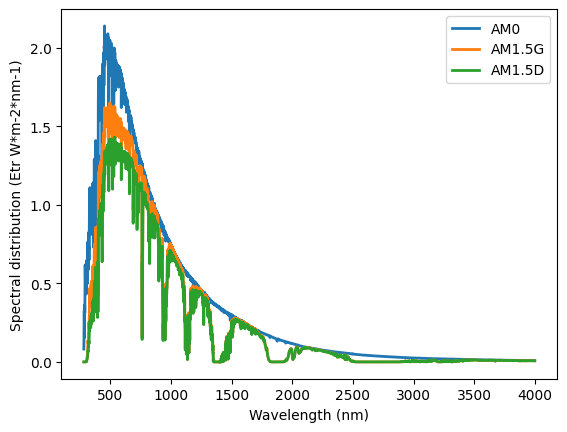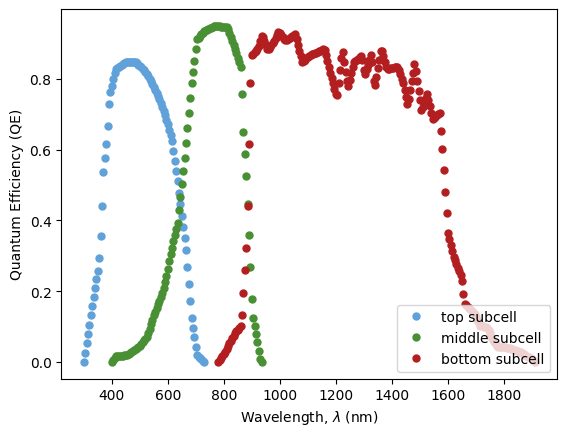Problem 15.7#
Fundamentals of Solar Cells and Photovoltaic Systems Engineering
Solutions Manual - Chapter 15
Problem 15.7
Figure 15.9 shows the Quantum Efficiency (QE) of a space triple junction solar cell at BOL. The tabulated data is available in the online repository of this book. Check if the total current and the top/mid current balance under the AM0 spectrum are better than the result obtained in Problem 15.6.
We will use the package pandas to handle the data and matplotlib.pyplot to plot the results.
import pandas as pd
import numpy as np
import matplotlib.pyplot as plt
We start by importing the data for the solar spectra.
datafile = pd.read_csv('data/Reference_spectrum_ASTM-G173-03.csv', index_col=0, header=0)
datafile
| AM0 | AM1.5G | AM1.5D | |
|---|---|---|---|
| Wvlgth nm | Etr W*m-2*nm-1 | Global tilt W*m-2*nm-1 | Direct+circumsolar W*m-2*nm-1 |
| 280 | 8.20E-02 | 4.73E-23 | 2.54E-26 |
| 280.5 | 9.90E-02 | 1.23E-21 | 1.09E-24 |
| 281 | 1.50E-01 | 5.69E-21 | 6.13E-24 |
| 281.5 | 2.12E-01 | 1.57E-19 | 2.75E-22 |
| ... | ... | ... | ... |
| 3980 | 8.84E-03 | 7.39E-03 | 7.40E-03 |
| 3985 | 8.80E-03 | 7.43E-03 | 7.45E-03 |
| 3990 | 8.78E-03 | 7.37E-03 | 7.39E-03 |
| 3995 | 8.70E-03 | 7.21E-03 | 7.23E-03 |
| 4000 | 8.68E-03 | 7.10E-03 | 7.12E-03 |
2003 rows × 3 columns
datafile.drop(datafile.index[0], inplace=True) #remove row including information on units
datafile=datafile.astype(float) #convert values to float for easy operation
datafile.index=datafile.index.astype(float) #convert indexes to float for easy operation
We can also plot the three spectra
plt.plot(datafile,
linewidth=2, label=datafile.columns)
plt.ylabel('Spectral distribution (Etr W*m-2*nm-1)')
plt.xlabel('Wavelength (nm)')
plt.legend()
<matplotlib.legend.Legend at 0x7fb4dfb8bc50>

We define the relevant constants and import the QE of the triple junction solar cell.
h=6.63*10**(-34) # [J·s] Planck constant
e=1.60*10**(-19) # [C] electron charge
c =299792458 #[m/s] Light speed
QE_top = pd.read_csv('data/EQE_TC_BOL.txt',
header=None, index_col=0, sep='\t').dropna().squeeze() #import dataframe and convert into series
QE_mid = pd.read_csv('data/EQE_MC_BOL.txt',
header=None, index_col=0, sep='\t').squeeze() #import dataframe and convert into series
QE_bot = pd.read_csv('data/EQE_BC_BOL.txt',
header=None, index_col=0, sep='\t').squeeze() #import dataframe and convert into series
We can plot the Quantum Efficiency.
plt.plot(QE_top, linewidth=0, label='top subcell', marker='.', markersize=10, color='#5FA1D8') #ligthblue
plt.plot(QE_mid, linewidth=0, label='middle subcell', marker='.', markersize=10, color='#498F34') #green
plt.plot(QE_bot, linewidth=0, label='bottom subcell', marker='.', markersize=10, color='#B31F20') #darkred
plt.ylabel('Quantum Efficiency (QE)')
plt.xlabel('Wavelength, $\lambda$ (nm)');
plt.legend(loc='lower right')
<matplotlib.legend.Legend at 0x7fb4df7a4b90>

For the top subcell, we calculate the spectral response, interpolate the spectrum, and integrate to obtain the short-circuit current density using Eq. 3.5.
\(J=\int SR(\lambda) \cdot G(\lambda) \ d\lambda\)
In this case, we assume the extraterrestrial irradiance AM0.
QE=QE_top
SR=pd.Series(index=QE.index,
data=[QE.loc[i]*e*i*0.000000001/(h*c) for i in QE.index])
spectrum='AM0'
spectra=datafile[spectrum]
spectra_interpolated=np.interp(SR.index, spectra.index, spectra.values)
J_top = np.trapz([x*y for x,y in zip(SR, spectra_interpolated)], x=SR.index)*1000/10000 # A-> mA ; m2 -> cm2
print('Photocurrent density top = ' + str(J_top.round(1)) + ' mA/cm2')
Photocurrent density top = 16.4 mA/cm2
/tmp/ipykernel_3716/431403739.py:9: DeprecationWarning: `trapz` is deprecated. Use `trapezoid` instead, or one of the numerical integration functions in `scipy.integrate`.
J_top = np.trapz([x*y for x,y in zip(SR, spectra_interpolated)], x=SR.index)*1000/10000 # A-> mA ; m2 -> cm2
We repeat the analysis for the middle subcell.
QE=QE_mid
SR=pd.Series(index=QE.index,
data=[QE.loc[i]*e*i*0.000000001/(h*c) for i in QE.index])
spectra=datafile[spectrum]
spectra_interpolated=np.interp(SR.index, spectra.index, spectra.values)
J_mid = np.trapz([x*y for x,y in zip(SR, spectra_interpolated)], x=SR.index)*1000/10000 # A-> mA ; m2 -> cm2
print('Photocurrent density middle = ' + str(J_mid.round(1)) + ' mA/cm2')
Photocurrent density middle = 18.2 mA/cm2
/tmp/ipykernel_3716/1830044442.py:8: DeprecationWarning: `trapz` is deprecated. Use `trapezoid` instead, or one of the numerical integration functions in `scipy.integrate`.
J_mid = np.trapz([x*y for x,y in zip(SR, spectra_interpolated)], x=SR.index)*1000/10000 # A-> mA ; m2 -> cm2
We repeat the analysis for the bottom subcell.
QE=QE_bot
SR=pd.Series(index=QE.index,
data=[QE.loc[i]*e*i*0.000000001/(h*c) for i in QE.index])
spectra=datafile[spectrum]
spectra_interpolated=np.interp(SR.index, spectra.index, spectra.values)
J_bot = np.trapz([x*y for x,y in zip(SR, spectra_interpolated)], x=SR.index)*1000/10000 # A-> mA ; m2 -> cm2
print('Photocurrent density bottom = ' + str(J_bot.round(1)) + ' mA/cm2')
Photocurrent density bottom = 29.7 mA/cm2
/tmp/ipykernel_3716/1590478743.py:8: DeprecationWarning: `trapz` is deprecated. Use `trapezoid` instead, or one of the numerical integration functions in `scipy.integrate`.
J_bot = np.trapz([x*y for x,y in zip(SR, spectra_interpolated)], x=SR.index)*1000/10000 # A-> mA ; m2 -> cm2
The current balance of the top and middle subcells (\(J_{SC,top}\)/\(J_{SC,middle}\)) can be calculated as follows:
J_top/J_mid
np.float64(0.9026416870694149)
In this case, the top subcell is limiting the current flowing through the device since it produces 10% less current than the middle subcell. We can say that here the match is better because the current produced by the top and mid subcell is more similar than in Problem 15.6.

